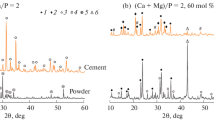Summary
Twenty-three specimen of methylmethacrylate-bone cement (PMMA), 30 days up to 101/4 years after their autopolymerization, has been analyzed in regard to the content of low-molecular substances. We were specially interested in the concentration of monomeres after long-time implantation, because the remainders of toxic monomeres are accused of being to be responsible for pathologic changes in bone site.
The analysis was made gaschromatographically, the identification of the different substances was done by comparing them with the mass-spectra of pure substances.
In none of the specimen could monomeres be detected. In 18 PMMA-specimen, implanted in man between 21/2 and 101/4 years 0.41 (±0.22)% w/w dimethyl-paratoluidine (DMpT) was found, as only detectible low-molecular substance. In 3 in vitro specimen the content of DMpT was 0.31 (±0.04)% w/w 30 days after polymerization.
As an additional proof for the method used, no DMpT could be found in 2 specimen PMMA initiated with an different system, namely tri-n-butylborane, 30 days after polymerization.
The relatively high concentration of DMpT in bone cement becomes understandable concerning the mechanism of the starting reaction.
DMpT is well known to be toxic even in low concentration.
Zusammenfassung
23 Methylmethacrylat —Knochenzementproben (PMMA) wurden 30 Tage bis 101/4 Jahre nach ihrer Herstellung auf ihren Gehalt an niedermolekularen Substanzen, insbesondere auf ihren Monomergehalt untersucht. Auch nach langjähriger Implantationszeit weisen pathologische Veränderungen an der Zement-Knochengrenze auf die Einwirkung eines toxischen Agens hin, wobei ein Restmonomergehalt des autopolymerisierenden PMMA angeschuldigt wird.
Die Untersuchung wurde gaschromatographisch durchgeführt, wobei durch die Koppelung mit einem Massenspektrometer die Identifikation der einzelnen Komponenten über den Vergleich mit Reinsubstanzen möglich war.
In keiner der untersuchten Proben konnte ein Monomergehalt nachgewiesen werden.
Bei den 18 implantierten PMMA Stücken mit einer Liegezeit von 21/2 bis 101/2 Jahren im Körper fand sich als einzige meßbare niedermolekulare Substanz Dimethyl-Paratoluidin (DMpT), ein Teil des Benzoylperoxyd — DMpT —Startersystems, in einer Menge von 0,41 (±0,22)% w/w.
Bei drei in vitro Proben PMMA fanden sich 30 Tage nach Herstellung 0,31 (±0,04)% w/w DMpT.
Zur zusätzlichen Kontrolle der Meßanordnung wurden noch zwei Proben PMMA mit einem Tri-n-Butylboran Starter, ebenfalls nach 30 Tagen analysiert, dabei konnte weder DMpT noch ein Monomergehalt nachgewiesen werden.
Die relativ hohe DMpT-Konzentration läßt sich mit dem Bildungsmechanismus der Starterradikale nach Mischung der beiden Zementkomponenten erklären.
DMpT ist bekannt als schon in geringen Mengen toxische Substanz.
Similar content being viewed by others
Literatur
Aldermaston K, Reading ML (1974) Eight-Peak-Index of Mass-Spectra Mass Spectromatic Data CenterAWRE, 2nd ed. Unwir Bros Ltd London
Batterton J, Winters K, Baalen Ch Van (1978) Anilines: Selective Toxity to Blue-Green Algae. Science 199: 1068–1070
Bechtel A, Willert HG, Frech HA (1973) Bestimmung des Monomergehaltes von Methacrylsäure-methylester in Knochenmark, Fett und Blut nach dem Aushärten verschiedener „Knochenzemente“. Chromatographia 5: 226–228
Bösch P, Kristen H, Zweymüller K (1980) An analysis of 119 loosenings in total hip endoprostheses. Arch Orthop Trauma Surg 96: 83–90
Elias HG (1975) Makromoleküle. 3. Aufl. Hüthig & Wepf, Basel, p 575
Iida M, Furuya K, Kawachi S, Masuhara E, Tarumi J (1974) New improved bone cement (MMA-TBB). Clin Orthop 100: 279–286
Kellner G (1973) Die Verwendung von Kunststoffen, im HNO-Bereich. Monatsschr Ohrenheilkd Laryngo-Rhinol Wien 107: 189–201
Kellner G (1976) Untersuchungen zur Eluierbarkeit von Knochenzement. Orthop Praxis 12: 624–629
Kusy RP (1978) Characterization of self-curing acrylic bone cements J Biomed Mat Res 12: 271–305
Lintner F, Bösch P, Brand G (1982) Histological examinations of remodelling proceedings on the cement-bone surface of endoprostheses after implantation from 3–10 years. Pathol Res Pract 173: 376–389
Sato T, Keta S, Otsu T (1975) A study on initiation of vinyl polymerization with diacyl-peroxi-de-tertiary amine systems by spin trapping technique. Makromol Chem 176: 561–571
Walling C, Indictor N (1958) Solvent effects and initiator efficiency in the benzylperoxide-dimet-hyl-aniline-system. JACS 80: 5814–5818
Weisburger E, Russfield AB, Homburger F, Weisburger JH, Boger E, Van Dongen CG, Chu KC (1978) Testing of twentyone enviromental aromatic amines or derivates for long-term toxicity or carcinogenicity. J Environ Pathol Toxicol 2: 325–356
Willert HG (1974) Die quantitative Bestimmung der Abgabe von monomerem Methylacrylat verschiedener Knochenzemente an das umgebende Gewebe während der Polymerisation. Sonderdruck der Battelle Information Nr. 18
Willert HG, Puls P (1972) Die Reaktion des Knochens auf Knochenzement bei der Alloarthroplastik der Hüfte. Arch Orthop Unfall Chir 72: 33–45
Author information
Authors and Affiliations
Rights and permissions
About this article
Cite this article
Bösch, P., Harms, H. & Lintner, F. Nachweis des Katalysatorbestandteiles Dimethylparatoluidin im Knochenzement, auch nach mehrjähriger Implantation. Arch Toxicol 51, 157–166 (1982). https://doi.org/10.1007/BF00302756
Received:
Issue Date:
DOI: https://doi.org/10.1007/BF00302756




